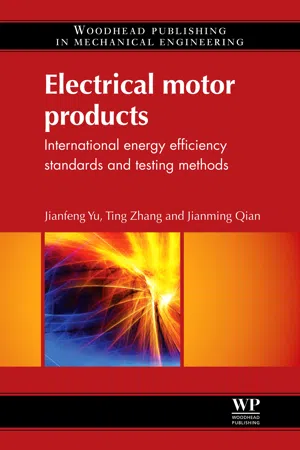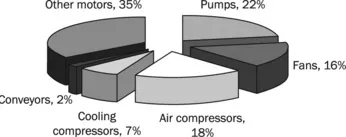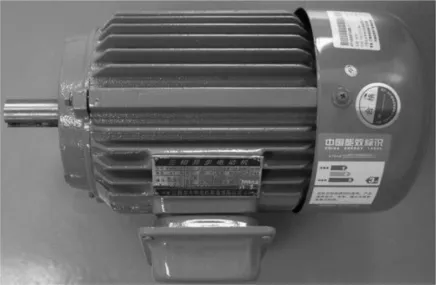
eBook - ePub
Electrical Motor Products
International Energy-Efficiency Standards and Testing Methods
Jianfeng Yu,Ting Zhang,Jianming Qian
This is a test
- 192 pages
- English
- ePUB (mobile friendly)
- Available on iOS & Android
eBook - ePub
Electrical Motor Products
International Energy-Efficiency Standards and Testing Methods
Jianfeng Yu,Ting Zhang,Jianming Qian
Book details
Book preview
Table of contents
Citations
About This Book
Electrical motor products reviews the energy efficiency management laws for electrical motor products in United States, European Union (EU) and China. The energy efficiency certification requirements for the electrical motor products vary from country to country and are summarised here. International standards, testing methods and certification requirements for specific electrical motor products are discussed, including electric motors, pumps and fans. Finally, methods for improving energy efficiency are examined.
- Reviews the energy efficiency management laws for electrical motor products in United States, European Union (EU) and China
- Highlights the importance of energy efficiency for electrical motor products
- Documents energy efficiency certification requirements for electrical motor products and how they vary from country to country
Frequently asked questions
At the moment all of our mobile-responsive ePub books are available to download via the app. Most of our PDFs are also available to download and we're working on making the final remaining ones downloadable now. Learn more here.
Both plans give you full access to the library and all of Perlego’s features. The only differences are the price and subscription period: With the annual plan you’ll save around 30% compared to 12 months on the monthly plan.
We are an online textbook subscription service, where you can get access to an entire online library for less than the price of a single book per month. With over 1 million books across 1000+ topics, we’ve got you covered! Learn more here.
Look out for the read-aloud symbol on your next book to see if you can listen to it. The read-aloud tool reads text aloud for you, highlighting the text as it is being read. You can pause it, speed it up and slow it down. Learn more here.
Yes, you can access Electrical Motor Products by Jianfeng Yu,Ting Zhang,Jianming Qian in PDF and/or ePUB format, as well as other popular books in Technology & Engineering & Electrical Engineering & Telecommunications. We have over one million books available in our catalogue for you to explore.
Information
1
Introduction: the importance of energy-efficiency for electrical motor products
Abstract:
This chapter introduces the application of electrical motor products. The chapter provides the history of the electric motor, pump and fan; it describes the current situation for the energy-efficiency of electrical motor products and points out the importance of energy-efficiency for electrical motor products against the low-carbon economy background.
Key words
electrical motor products
energy-efficiency
1.1 The application of electrical motor products
Global climate change has led to great concerns by global society. The negative impact of greenhouse gases (GHG) on climate change is clear now. The reduction of GHG can be achieved either by reducing total energy consumption or by increasing energy-efficiency. Improving energy-efficiency has received considerable attention as a way of reducing GHG emissions and alleviating energy shortage. In recent decades, much work has been done to improve the energy-efficiency of various equipment and appliances, including:








As for developed countries, the Group of Eight (G8: Canada, France, Germany, Italy, Japan, Russia, the United Kingdom and the United States) has achieved great progress in the energy-efficiency field. The G8 represents a significant share of world primary energy consumption (about 46 per cent) (United Nations Foundation, 2007). By working effectively with the + 5 nations (China, India, Brazil, Mexico and South Africa), the G8 countries can spur efficiency improvements in economies that together consume nearly 70 per cent of global primary energy. As for developing countries, for example, China, Brazil, India, Mexico and South Africa have made effective energy-efficient policies and measures to accomplish the low-carbon emission target.
With regard to electrical motor products, the International Energy Agency (IEA) regards electric motor, pump, fan and compressor as industrial motors. Electrical motor products have been widely applied in industry, consuming roughly 60 per cent of electricity in industry, or 40 per cent of global electricity, as IEA surveyed. Electric motors supply mechanical energy through the electromagnetic transformation principle, while pumps and fans supply fluid energy. Electrical motor products are widely applied in industry, agriculture, and so on. Electric motors, pumps and fans are by far the most important loads in industry, accounting for 73 per cent (Figure 1.1) of total motor electricity consumption (Almeida et al., 2003). In this book, electric motors, pumps and fans are researched and discussed from the energy-efficiency point of view: the energy-efficiency standards and testing methods are discussed in detail.

Figure 1.1 Disaggregation of motor electricity consumption by end-use in the industrial sector (Used with permission of Prof. Anibal T. de Almeida)
Roughly 30 million new electric motors are sold each year for industrial applications; some 300 million motors are in use in industry, infrastructure and large buildings. Therefore, improvements in the energy-efficiency of electric motors can reduce greenhouse gas emissions. Pumps and fans are important fluid machines, popularly used around the world, so accurately measuring the hydraulic efficiency of the pump and fan is of great importance from an economic point of view.
1.2 The history of electrical motor products
1.2.1 Electric motors
The discovery of the induction law came around 1831 from Faraday and Maxwell’s formulation of the laws of electricity. Faraday had a rotating homo-polar motor in 1831, which is the first electric motor in the world. The induction motor has two fathers: Galileo Ferraris (1885) and Nikola Tesla (1887). The electric motor greatly pushed the industry towards automation, which was an important development in the twentieth century. The induction motor is the main part of electric motors applied in industry (see Figure 1.2).

Figure 1.2 The induction motor
1.2.2 Pumps
A pump is a machine for raising, transferring or compressing fluids. The importance of the pump in the hydraulic field has been known since the Egyptians invented the shadoof in 2000 BC (World Pumps, 2009). The centrifugal pump is one of the most important types of pump and is widely used in power generation, environmental protection, the petrochemical industry and other various industrial fields. The first systematic investigations of rotodynamic pumps on a scientific basis were started in 1890 at the works of Sulzer Brothers in Switzerland. After that, other factories endeavoured to become leading manufacturers of centrifugal, helicoidal, diagonal and axial flow pumps.
In North America, the largest association of pump industry manufacturers is the Hydraulic Institute, which was founded in 1917. The European Working Group of Pump Manufacturers (Europump) was established in 1959. Europump has grown massively in stature and effectiveness since its foundation and now works in close partnership with the Hydraulic Institute in the US.
1.2.3 Fans
Fans, blowers and compressors are differentiated by the method used to move the air. Fans of all types are used in many different applications, such as ventilation and airconditioning systems, process engineering, drying, pneumatic conveying, combust...
Table of contents
- Cover image
- Title page
- Table of Contents
- Copyright
- List of figures and tables
- Acknowledgements
- About the authors
- Chapter 1: Introduction: the importance of energy-efficiency for electrical motor products
- Chapter 2: Classification: electric motors, pumps, fans
- Chapter 3: Energy-efficiency technical measures system for electrical motor products
- Chapter 4: Energy-efficiency standards of electrical motor products
- Chapter 5: Measurement errors and uncertainties
- Chapter 6: Testing methods for electric motors
- Chapter 7: Efficiency testing methods for centrifugal pumps
- Chapter 8: Efficiency testing methods for centrifugal fans
- Chapter 9: How to improve the energy-efficiency of electrical motor products
- Chapter 10: Modern control methods for the induction motor
- Index